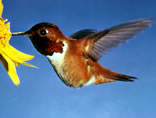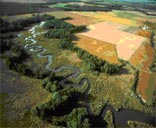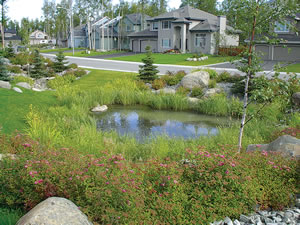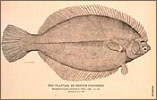Science Features
EPA scientists have initiated a new interdisciplinary research program to better understand how the maintenance of healthy ecosystems and biodiversity can protect people from emerging infectious diseases such as West Nile virus and Lyme disease. Read More
The breath you “see” on a cold winter’s day may become a useful diagnostic tool for identifying lung changes or damage from air pollutants. At EPA’s Office of Research and Development, scientists are at the forefront of new biomarker research. Read More
Looks can be deceiving. Over the past two decades, waters in many parts of the Northern Hemisphere have become more colored, due to increasing concentrations of dissolved organic carbon, or DOC. Read More
It was a mystery. Louisiana environmental officials in Baton Rouge wanted to know why ozone levels were spiking above EPA's limits to protect health on days when they should have been lower. Read More
To check a patient's health, physicians use simple blood pressure tests to sophisticated and expensive diagnostics. Natural resource managers also have a variety of assessment tools ranging in complexity, accuracy and cost at their disposal to check the health of wetlands. Read More
Finding a moving target can be difficult. Such is the case with chemicals from leaking underground storage tanks which can move in many ways into the ground and groundwater.
Read More
Old Mines, New Technology
EPA researchers are developing ways to use tiny microbial organisms to clean up old, abandoned mines in the American West.
Read More
Along the Road
EPA Scientists are developing innovative ways to study how air pollution along major roadways might affect nearby neighborhoods.
Read More
Mapping the Future
Forecasting the future has been made easier for environmental planners thanks to new Web-based tools developed by EPA's Office of Research and Development.
Read More
17 Cows per Tank
Sports cars and school buses powered on fuel harvested from cow manure? It could happen, thanks to innovative designs recently awarded EPA's P3 Award for Sustainability.
Read More
Watching Hummingbirds
A team of EPA researchers are keeping an eye on hummingbird feeding activity to gain insights into how air pollution, particularly exposure to elevated ozone levels, might affect hummingbirds and other wildlife.
Read More
What's Wrong with Your Stream?
Ask CADDIS-EPA's on-line tool to help scientists, engineers, watershed managers, and others identify the potential causes of trouble in their local waterways.
Read More
An American Engineer in Jordan
EPA engineer Thabet Talaymet is helping the Kingdom of Jordan end the environmental nightmares associated with the Russeifah landfill.
Read More
More Green for the Green
With an assist from EPA scientists, officials with the Maryland Department of Natural Resources developed a scientific strategy to protect the state's "green infrastructure."
Read More
Sustainability: the Next Step
Today's EPA is working to help businesses and consumers become better stewards of the environment.
Read More
Network News
What do dental schools, rain gardens, and office parks have in common? They are all part of EPA's Collaborative Science and Technology Network for Sustainability (CNS).
Read More
Listening to the Loons
The distinctive, almost-haunting call of the common loon is to New England what the howl of the wolf is to the American West: it's the sound of wilderness.
Read More
Impervious Cover
Where does your rain fall? EPA engineers are developing a tool for estimating the amount of impervious cover in local watersheds.
Read More
Winning Ideas
"Green" dorms, biodiesel buses, and new ways
to remove arsenic from groundwater are some of the winning
projects from this year’s EPA P3 competition.
Read More
Safe Harbors
Michael Blum and his colleagues at EPA’s Molecular
Ecology Research Branch are searching for high-tech ways
to screen ships for invasive species.
Read More
Keeping an Eye on Coastal Waters
EPA researchers are using novel, efficient methods to
measure the effects of nitrogen on the nation's coastal
waters.
Read More
EPA Scientists Developing New
Ways to Assess Coastal Wetlands
EPA research is helping states and tribes across New England
get a clearer picture of the condition of their coastal
wetlands.
Read More
Tiny Snail, Big Trouble?
EPA researchers recently discovered a potentially troublesome invader in Lake Superior: the New Zealand mudsnail (Potamopyrgus antipodarum).
Read More
EPA Ecology Group Makes
Big Splash
To protect and manage coastal areas, home to over half the U.S. population,
the Environmental Protection Agency produces the National Coastal Condition
Report.
Read More
Helping Streams Help Themselves
A stream in Towson, Maryland, is where EPA scientists are learning to apply engineering techniques to help urban waterways.
Read More
The Big Picture: The Integrated Ocean Observing System
EPA scientists are partners in this major new effort to monitor and protect our Coastal, Marine, and Great Lakes environments.
Read More
EPA Finds a Way
EPA scientists are developing the protocols and tools needed to assess the nation’s large rivers and streams. Read More
Field of Dreams
Thanks to EPA supported research, that clear plastic container holding your Brussels sprouts might be made of an edible plant itself — corn.
Read More
EPA Scientist Mussels Up
While most people think of the menu from their favorite seafood restaurant when they hear the word "mussel," EPA research chemist Barbara Bergen thinks: data collectors.
Read More
Reading Flounder
Read any good flounder lately? Scientists at EPA's Atlantic Ecology Laboratory are studying how to "read" winter flounder in order to better protect the species and its habitat.
Read More
What Story Does Your Waterfront Tell?
Highly degraded urban areas have a story to tell. The actions that drive urbanization create an accumulation of impacts, some irreversible.
Read More
![[logo] US EPA](https://webarchive.library.unt.edu/eot2008/20081013132533im_/http://www.epa.gov/epafiles/images/logo_epaseal.gif)





























